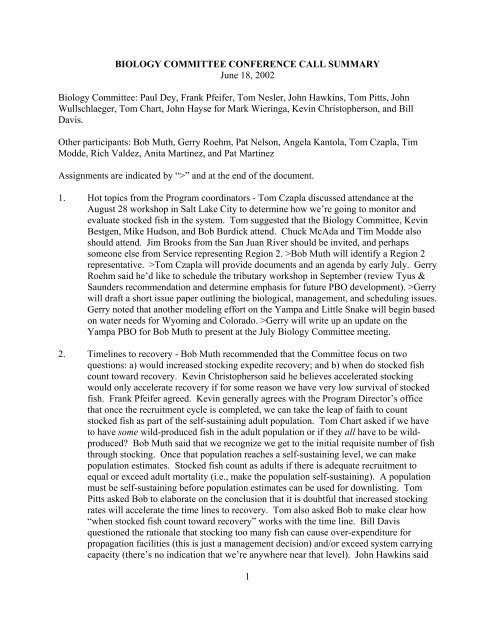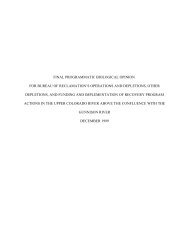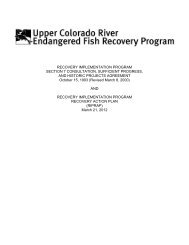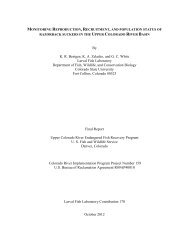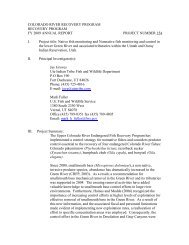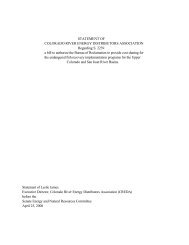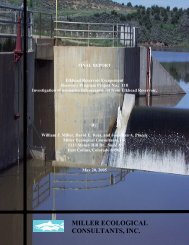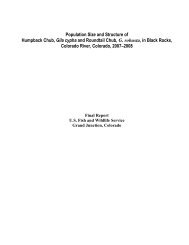18 - Upper Colorado River Endangered Fish Recovery Program
18 - Upper Colorado River Endangered Fish Recovery Program
18 - Upper Colorado River Endangered Fish Recovery Program
You also want an ePaper? Increase the reach of your titles
YUMPU automatically turns print PDFs into web optimized ePapers that Google loves.
BIOLOGY COMMITTEE CONFERENCE CALL SUMMARY<br />
June <strong>18</strong>, 2002<br />
Biology Committee: Paul Dey, Frank Pfeifer, Tom Nesler, John Hawkins, Tom Pitts, John<br />
Wullschlaeger, Tom Chart, John Hayse for Mark Wieringa, Kevin Christopherson, and Bill<br />
Davis.<br />
Other participants: Bob Muth, Gerry Roehm, Pat Nelson, Angela Kantola, Tom Czapla, Tim<br />
Modde, Rich Valdez, Anita Martinez, and Pat Martinez<br />
Assignments are indicated by “>” and at the end of the document.<br />
1. Hot topics from the <strong>Program</strong> coordinators - Tom Czapla discussed attendance at the<br />
August 28 workshop in Salt Lake City to determine how we’re going to monitor and<br />
evaluate stocked fish in the system. Tom suggested that the Biology Committee, Kevin<br />
Bestgen, Mike Hudson, and Bob Burdick attend. Chuck McAda and Tim Modde also<br />
should attend. Jim Brooks from the San Juan <strong>River</strong> should be invited, and perhaps<br />
someone else from Service representing Region 2. >Bob Muth will identify a Region 2<br />
representative. >Tom Czapla will provide documents and an agenda by early July. Gerry<br />
Roehm said he’d like to schedule the tributary workshop in September (review Tyus &<br />
Saunders recommendation and determine emphasis for future PBO development). >Gerry<br />
will draft a short issue paper outlining the biological, management, and scheduling issues.<br />
Gerry noted that another modeling effort on the Yampa and Little Snake will begin based<br />
on water needs for Wyoming and <strong>Colorado</strong>. >Gerry will write up an update on the<br />
Yampa PBO for Bob Muth to present at the July Biology Committee meeting.<br />
2. Timelines to recovery - Bob Muth recommended that the Committee focus on two<br />
questions: a) would increased stocking expedite recovery; and b) when do stocked fish<br />
count toward recovery. Kevin Christopherson said he believes accelerated stocking<br />
would only accelerate recovery if for some reason we have very low survival of stocked<br />
fish. Frank Pfeifer agreed. Kevin generally agrees with the <strong>Program</strong> Director’s office<br />
that once the recruitment cycle is completed, we can take the leap of faith to count<br />
stocked fish as part of the self-sustaining adult population. Tom Chart asked if we have<br />
to have some wild-produced fish in the adult population or if they all have to be wildproduced<br />
Bob Muth said that we recognize we get to the initial requisite number of fish<br />
through stocking. Once that population reaches a self-sustaining level, we can make<br />
population estimates. Stocked fish count as adults if there is adequate recruitment to<br />
equal or exceed adult mortality (i.e., make the population self-sustaining). A population<br />
must be self-sustaining before population estimates can be used for downlisting. Tom<br />
Pitts asked Bob to elaborate on the conclusion that it is doubtful that increased stocking<br />
rates will accelerate the time lines to recovery. Tom also asked Bob to make clear how<br />
“when stocked fish count toward recovery” works with the time line. Bill Davis<br />
questioned the rationale that stocking too many fish can cause over-expenditure for<br />
propagation facilities (this is just a management decision) and/or exceed system carrying<br />
capacity (there’s no indication that we’re anywhere near that level). John Hawkins said<br />
1
he believes we should only count wild-produced fish. Bill Davis asked what if it 58,000<br />
adults are required to have 5,800 adults producing in the system The Committee asked<br />
if our survival rates turn out to be lower than predicted, do we have the capacity to<br />
produce more fish >Tom Czapla will outline the production capacity we have. The<br />
Committee generally agreed on “when the clock starts” (when we have a self-sustaining<br />
population). Tom Nesler opposes the idea that stocked fish are somehow “lesser<br />
entities” until their young recruit. Bob Muth responded that of course stocked fish are<br />
important because they represent the founding stock upon which self-sustaining<br />
populations will be built. The <strong>Program</strong> will need to monitor stocked fish to determine<br />
whether targets of fish abundance and population structure are being achieved in the<br />
expected time frame. >Tom Czapla will put together a list of documents that will be<br />
pertinent to the monitoring stocked fish workshop. The workshop will be expanded to<br />
include a reassessment of the current stocking plans (<strong>Upper</strong> Basin and San Juan <strong>River</strong><br />
Basin) and associated capacity of existing propagation facilities. Bob Muth will add<br />
some text to the time lines to recovery document that explains self-sustaining populations<br />
could be established before 2015 and clarify other points as recommended. >The<br />
<strong>Program</strong> Director’s office will revise the document and send it out by the end of this<br />
week to the Biology and Management committees.<br />
3. Ongoing-revised 2002 scopes of work (C-<strong>18</strong>/19) - Tom Chart endorsed the isotope work<br />
and suggested initial emphasis be placed on that component of the proposal in hopes that<br />
it could provide useful information towards screening. Committee members indicated<br />
that the highest priority for the isotope work should be directed at determining whether<br />
the majority of centrarchids in the river are of pond or river origin. If centrarchids in the<br />
river are sustained primarily by reproduction in backwaters or wetlands that are attached<br />
to main channel under a wide range of flows, is the screening of irrigation drains a good<br />
use of project funds Anita Martinez said she is certain that nonnative fish are coming<br />
from ponds, but we need the isotope study to determine if there’s also a reproducing<br />
population in the river. John Wullschleger suggested the project needs to be re-focused<br />
to “Nonnative <strong>Fish</strong> Control in Areas with Abundant Centrarchids”. If it is determined<br />
that ponds are a major contributor of centrarchids to the river, then we need to focus on<br />
which habitats are the greatest contributors. Tom Pitts and others suggested we need to<br />
understand the scope of the problem. Are ponds a major source of nonnatives, thus<br />
making screening warranted How many screens will be needed and what will they cost<br />
Should we screen for storm events The Committee recommended a phased approach,<br />
with research on screen design and isotope work beginning this year. We need to shorten<br />
the scope of work to show what we’ll do in 2 years of design study and isotope work,<br />
then what we’ll do if we proceed with the studies. The first two years of work also need<br />
to determine the magnitude of the project (if we’re going to proceed, we’ll need to install<br />
how many screens and the cost will be how much). >Tom Chart will determine if<br />
Reclamation can assist with the engineering portions of the scope of work. Tom Pitts<br />
questioned the backwater monitoring portion of the scope of work. >Anita and Pat<br />
Martinez will send a revised draft of the scope of work to the Biology Committee by<br />
July 1. The scope will have four parts: 1)screen criteria; 2) isotope; 3) overall plan; and<br />
4) monitoring. >Committee members will submit any additional comments to Pat and<br />
2
Anita by the end of this week. Most of the revisions discussed are for 2003. Remaining<br />
2002 funds would be used for preliminary work (which will be clarified in the scope of<br />
work on page 12). The scope will show what’s already been spent in 2002 and what<br />
remains (and what that will be spent on). The Biology Committee will review the revised<br />
scope of work on July 24.<br />
4. Next meeting - Meeting on July 24 from 8-4 in Denver to discuss the Gunnison <strong>River</strong><br />
flow recommendations report, Nesler’s two reports, possibly other reports, and the<br />
revised C-<strong>18</strong>/19 scope of work. New starts and other revisions to 2003 scopes of work<br />
will be discussed in August 27 from 8-4 in Salt Lake City.<br />
3
ASSIGNMENTS<br />
Gerry Roehm will draft a short issue paper outlining the biological, management, and scheduling<br />
issues on tributaries/PBO’s.<br />
Gerry Roehm will write up an update on the Yampa PBO for Bob Muth to present at the July<br />
Biology Committee meeting.<br />
For the August 28 workshop on monitoring stocked fish, Bob Muth will identify a Region 2<br />
representative. Tom Czapla will distribute documents (and a list of related documents) and an<br />
agenda for this meeting by early July. Tom also will outline our current hatchery production<br />
capacity. The workshop will be expanded to include a reassessment of the current stocking plans<br />
(<strong>Upper</strong> Basin and San Juan <strong>River</strong> Basin) and associated capacity of existing propagation<br />
facilities.<br />
Bob Muth will add some text to the “time lines to recovery” document that explains selfsustaining<br />
populations could be established before 2015 and clarify other points as<br />
recommended. The <strong>Program</strong> Director’s office will revise the document and send it out by the<br />
end of this week to the Biology and Management committees.<br />
Tom Chart will determine if Reclamation can assist with the engineering portions of the C-<strong>18</strong>/19<br />
nonnative fish control scope of work.<br />
Committee members will submit any additional comments on the C-<strong>18</strong>/19 scope of work to Pat<br />
and Anita Martinez by the end of this week. Anita and Pat will send a revised draft of the scope<br />
of work to the Biology Committee by July 1. The Biology Committee will review the revised<br />
scope of work on July 24.<br />
4


